Dr. Wily’s fourth and final stage doesn’t offer many threats, but the ones it does contain mean business. The opening screens feature those floating guys from early in Elec Man’s stage, who attack with the same pincher maneuvers of two sets of three hovering in from both above and below. Here, though, they attack while you’re climbing a long, long ladder with no safe platform to count on as you could when you dealt with them in Elec Man’s lair. You need to clear them out quickly and efficiently, or else they’ll knock you loose from the ladder and drop you to the beginning of the stage.
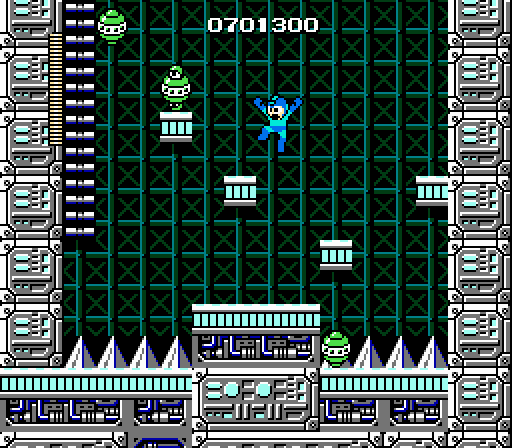
The level moves into a horizontal layout after the initial ascent, a long hallway dotted with alcoves in which pop-up turrets have been set. Because of the physical design of the recesses, you can’t easily shoot the turrets from the side, while they’re positioned perfectly to hit you from oblique angles. Your best bet is to hit them with the Thunder Beam’s vertical elements — though the final pair of turrets, which appear one above the other and operate on the same timing, are almost impossible to take out without soaking up a hit yourself — and quickly advance to the next.
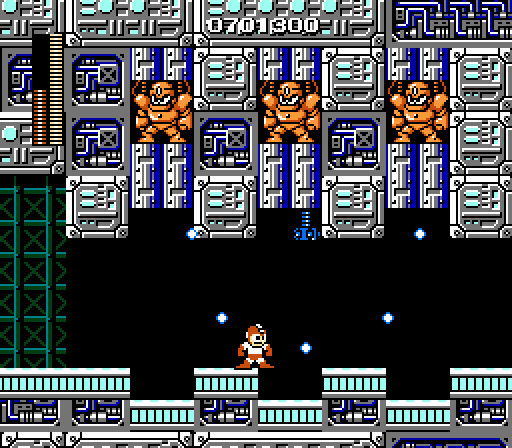
In a nice bit of storytelling through level design, this final gauntlet reveals Dr. Wily’s ultimate scheme: Mass production of the Robot Masters. Inert Guts Men stand in capsules that line the ceiling, ready to march upon humankind and conquer the world by throwing cubes of rock that fall mysteriously from the sky. This explains where the duplicates of Elec Man and Cut Man in Wily Stage 2 came from… not to mention the other four Robot Master clones you’re about to face off against.
But first, one final platforming challenge: One of those flipping platforms on a damaged transom, as seen at the beginning of Guts Man’s stage. If you happened to begin the game by taking on Guts Man (like I frequently do), these things neatly bookend Mega Man. The frayed portion is extremely wide here, so it’s much easier to simply travel the Magnet Beam highway to the safe platform above the middle portion of the cable, then jump down onto the platform as it passes beneath you to the right before letting it deposit you on the platforms where you can collect a Yashichi symbol (which refills all of Mega Man’s energy — not just his health, but his weapons as well) and a 1UP.

On the platform above the Yashichi stands a teleporter that takes you to the final challenge of the game: Clones of the other four Robot Masters you haven’t yet faced in Wily’s stages, and the mad doctor himself. You have to survive all four of the bosses without a break or a health refill in order to reach Dr. Wily, and it can be pretty rough.
The sequence begins with Bomb Man, then moves to Fire Man, Ice Man, and finally Guts Man. Your chances of making it through all four fights unscathed is roughly zero thanks to Fire Man’s spammy attacks, but with smart play it’s theoretically possible. Since you’ve already fought these guys, you know their tricks, tactics, and weaknesses. And unlike the previous redux encounters, you aren’t limited by the placement of objects in the room.
The big danger here comes from the teleporters that connect the rooms. You materialize on the left side of the screen in a teleport pod, which has a low ceiling. If you don’t run immediately to the right once you enter a room, it’s frustratingly easy to become trapped in the teleporter while a boss pummels you with attacks.

Bomb Man, the first foe you face, demonstrates this danger quite clearly. He jumps toward you and tosses bombs whose explosive radius pushes you backward, forcing you to box yourself into the teleporter. The only safe tactic is actually to rush Bomb Man and move as close to him as possible, which will cause him to jump backward to put some distance between you — after all, he doesn’t want to catch himself with his own splash damage, right? It’s a tiny but wholly logical detail that works to your advantage.
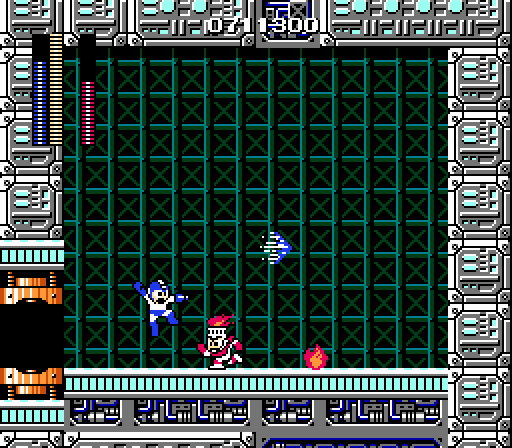
Fire Man is more difficult, since he blasts you with a rapid barrage of fire that ignites under your fire even as it flies across the room. Getting in close and trading blows is the safest solution. On the other hand, if you deal with Ice Man correctly, hitting him with three blasts of Thunder Beam as efficiently as possible, you don’t even need to move from the teleport pad. You’ll take him out before his Ice Slasher attacks crawl across the room, and if you’re still standing in the teleporter, you’ll be whisked instantly to Guts Man redux the instant Ice Man explodes. From there it’s a simple matter of jumping over the rocks Guts Man heaves and hoping he doesn’t decide to make a stand in the same spot where you’re standing.
In the end, all that remains is Dr. Wily, who putters onto the screen in the UFO he hailed when you picked his icon on the stage select screen. A large and vaguely humanoid mechanical creation materializes beneath the saucer — Wily Machine 1 — and immediately begins spewing bullets at you.
Wily Machine 1 appears in two phases (one of the earliest examples of this hoary video game cliché in action), each with its own health meter; once you destroy the first phase, its health regenerates as the doctor’s control chamber in the machine’s “chest” is exposed. While this sounds daunting, especially coming off the awful boss gauntlet, it’s not so bad. Each form of the Wily Machine uses only a single attack pattern, and those projectiles are easily avoided.
If you fall to the Wily Machine, you begin immediately outside the final chamber where a large weapon energy refill always appears. Not only that, but the 1UP you can pick up immediately before entering the boss gauntlet every time you take it on should ensure that no matter how many times you fell to the Robot Masters redux, you’re going to have maximum lives (and possibly more) once you reach Wily. In other words, the designers have made every effort to ensure that when you get to this climactic final moment of the game, you’ll be able to take several consecutive cracks at beating the game. While other portions of the game have been considerably less thoughtful than this — that Magnet Beam bit in Wily 1 comes to mind — here in the final moments we see the vindictive and abusive game design habits of old beginning to melt away toward a more considerate mindset.

Wily Machine 1 drifts back and forth across the screen in both of its phases. Its initial tactic is to wield a rounded turret that rotates to take aim at Mega Man with plasma balls similar to the one Mega Man’s P cannon fires. The difference is that they don’t fire directly at Mega Man; instead, they fire up in a short arc before descending toward the spot at which Mega Man stood at the instant they were disgorged. The pellets fire in rapid succession, but it’s not unreasonably difficult to evade the bullets while jumping up to hit the machine in its weak point… which, here, happens to be the turret itself.
At this point, the game fully expects you to have figured out the fine art of experimenting with weapons in a combat situation. Obviously, certain of Mega Man’s arsenal will be utterly useless here; the turret is situated well above the Hyper Bomb’s blast radius, and the lack of blocks in the room puts the “superficial” in “Super Arm.” The Fire Storm, however, doesn’t simply hit the turret for respectable damage, it also has the benefit of that orbiting bit. When your evasion pattern brings you close to Wily Machine 1, you can score double damage with the proper timing. In short order, you should break away the machine’s protective shell… and if you don’t make it out of the next phase alive, the Fire Storm is efficient enough here that the energy refill capsule you pick up after you respawn will nearly top it off.
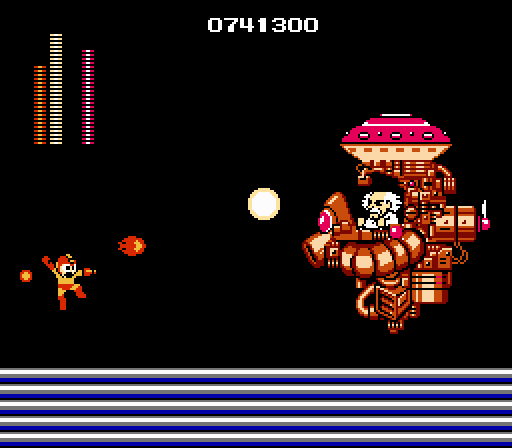
The second form, unfortunately, lacks a real weakness. There’s really nothing to be done for it but to evade its attacks and return fire by jumping and firing. Once Wily’s control chamber becomes exposed, Wily Machine 1 emits a large beam that somewhat resembles the Fire Storm’s orbiting bit. Only here, rather than revolving around the Wily Machine, the beam flies toward Mega Man’s position in a circular wave, spinning counter-clockwise. The corkscrew motion of the beam actually works against it, though; if you move to the right once the machine fires the weapon, the beam pattern sends the projectile spinning away from Mega Man. Moving in close to the machine every time it attacks is, counterintuitively, the safest move here.

Once you whittle down Wily Machine 1’s armor and health, it explodes and Dr. Wily surrenders. You’ve beaten one of the most complex console action games ever designed as of 1987: A game that offered unprecedented freedom for tackling its challenges and a complex mix of skills. While it wasn’t perfect, Mega Man really demonstrated some smart design choices that nudged the player toward learning optimal patterns and sequences through experimentation… and the parts that didn’t work would be smoothed over considerably in its superlative sequel.
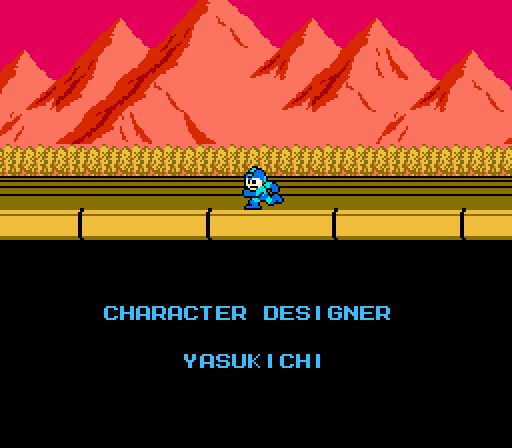


I must admit that I never realized the Gutsman factory part, shame on me. Wily four is really just a transport stretch before the boss gauntlet, and the boss gauntlet is really about beating Fireman with a little bit of energy left (provided that Gutsman doesn’t jump into you). But that Fireman is one nasty fella, and the one boss in any Mega Man game (except the wall boss from MM II) who I don’t really master completely.
It’s a good thing that you start at Wily if you get through the gauntlet once, and even better that the Wily bosses aren’t really that hard.
By the way: yet another great read, Parish, you really have a keen understanding of the gaming medium, its peculiarities and possibilities. Thank you.
Another aside: upon playing Bionic Commando again, it struck me that the final boss looks a lot like Wily’s own robot. Are there other Capcom games with similar bosses?
I never realized that Dr. Wily may have been intending to mass produce robot masters either, and I think that’s because the original Mega Man isn’t very special compared to most of its sequels, so people tend to play it last as they work their way through the series. That means that they see Guts Man G in Mega Man 7, Guts Tank in Mega Man 2, Gori-Three in Mega Man 8/Mega Man and Bass, Gamma in Mega Man 3, Guts Hover in Mega Man IV, and then when they finally get to this stage and see the capsules in the ceiling, they think, “Wow, even from the very beginning, Dr. Wily REALLY liked Guts Man.”
Yup. Someone on the development team had a real fixation on Guts Man for all those years.
Which strikes me as odd, since in the original Mega Man I think a case can be made that Guts Man is by far the least interesting Robot Master, and about all he’s got going for him is having the funniest name of any of the original 6 bosses. He has the shortest level with the least to do in it, he’s one of those bosses that isn’t really hard, but is just kind of annoying and time-consuming to fight, and he gives you a weapon that you flat-out can’t use most of the time.
(The gameplay mechanic of the Super Arm was quite innovative for a game released in 1987, but it doesn’t work very well without having a steady supply of bricks to throw. Perhaps it’s not coincidental that a couple of years after the original Mega Man, Capcom made Chip ‘n’ Dale Rescue Rangers, with gameplay that mainly involves picking up boxes and throwing them at stuff, just like the Super Arm, but you don’t ever have to worry about not having any boxes handy, because there are absolute loads of them everywhere.)
I think maybe they just liked the strong, brutish design with the lantern jaw. It would explain why we’ve seen it used in other Robot Masters, such as Stone Man and Concrete Man- who are usually regarded as friends of Guts Man.
Heh, it’s funny how many people didn’t realize this whole facility was Wily’s robot factory. That is, there are a LOT who haven’t, so if you didn’t, don’t feel bad.
As for me, i never thought of the Wily Machine as being humanoid in any way. Fascinating take on it… I wonder if anyone’s ever done anything with that line of thought, art-wise…